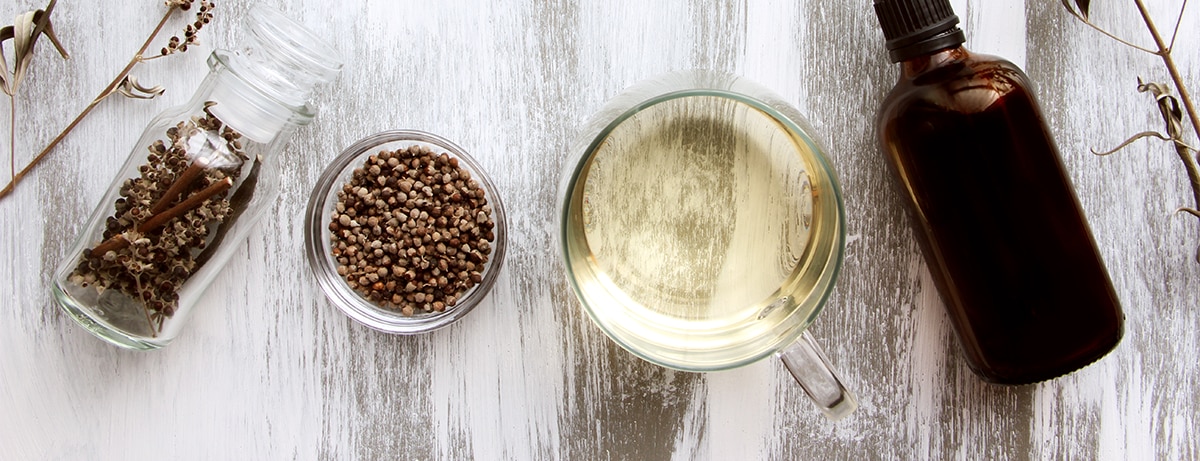10% off £35
CBT techniques to cope with menopause

During the perimenopause you might have symptoms like: Hot flushes, night sweats and poor sleep, heart palpitations, joint pains, anxiety and low mood and brain fog.
These are mostly triggered by declining oestrogen levels throughout your menopause transition. Replacing oestrogen using Hormone Replacement Therapy (HRT) can help.¹ However, if you can’t take it or you’d prefer a non-hormonal approach, Cognitive Behavioural Therapy (CBT) techniques might help you better understand your emotions during this time.
What is CBT?
What is CBT?
CBT is a type of talking therapy based on the idea that thoughts, feelings, what we do, and how our bodies feel are all connected.
There’s growing evidence to suggest that it can help those struggling with the menopause.²
Many symptoms, like hot flushes, can be more troubling depending on your underlying emotions.
For example, studies have shown that people who feel anxious, frustrated, embarrassed, and stressed tend to experience more hot flushes and night sweats - and these can be more severe.³


Change your thoughts, improve your symptoms
Negative emotions are completely understandable, as menopause symptoms can be difficult.
The good news is that if you can find ways to change your feelings, thoughts, and beliefs, this in turn may improve your symptoms.
CBT has been shown to be effective in improving emotional and physical symptoms of the menopause including stress, low mood, sleep problems, hot flushes, and night sweats.
It’s recommended in the NICE guidelines for menopause, and studies have shown that CBT can help women have a better quality of life.⁴⁵
Let’s look at some of the techniques…
Technique 1: Breathe
Technique 1: Breathe
Deliberately slowing your breathing can help to calm your nervous system.
Try inhaling deeply for 4 seconds and breathing out for 6 or 7 seconds. It’s more effective if you do it regularly, so keep practising!
Once you feel comfortable with this technique, you can use it when menopause symptoms arise and any time you’re stressed or anxious.


Technique 2: Take the power out of your thoughts
Negative thoughts can set off a chain of events that make symptoms worse.
For example, if you begin to experience symptoms of a hot flush, you may think something like: “Oh no, I’m going to turn red and sweaty - it’s going to be so embarrassing.”
Feeling like this is understandable, but this thought can have its own impact on your body by setting off its “stress response”.
This often involves an increase in heart rate, breathing rate, a dry mouth, palpitations, or a sense of doom. Combine these with the original hot flush symptoms and you’re well on your way to feeling even more distressed and uncomfortable.
Luckily, there’s a technique which helps you to distance yourself from unhelpful thoughts before they cause a problem…


Thought defusion
“Thought defusion” is a strategy from Acceptance and Commitment Therapy that helps to reduce the negative impact of thoughts.
The first step is to notice the thought or feeling you are experiencing. Name it, either in your head or out loud.
Using the hot flush example, you could say: “I’m having the thought that everyone will notice me going red.”
Then to distance yourself even further from the thought, try adding, “I notice that I’m having the thought that everyone will notice me going red.”
It might seem unfamiliar at first, but it can be surprisingly effective at reducing the power of your thoughts.
Technique 3: Make a night-time plan
Technique 3: Make a night-time plan
Waking up at night is common during the menopause. It can relate to anxiety, night sweats, or urinary symptoms, and sometimes there’s no obvious reason.
Night waking can become a vicious cycle. You might become anxious and frustrated about not being able to sleep, which in turn makes drifting off again even harder! Having a clear step-by-step plan of how to approach night-time awakenings can take the pressure off:


- If you don’t think you’ll get back to sleep quickly, try cooling your body down. This may involve getting out of bed; perhaps putting bare feet on a cold bathroom floor.
Try to combine this with a breathing exercise (as above) to maximise the calming benefits.
- If you have night sweats, you may need a change of clothes. Try getting them ready before bedtime.
- When you return to bed, be aware of negative thoughts which may get in the way of sleep (try the thought defusion technique above).
- Then, perhaps do some breathing or relaxation exercises while waiting to feel sleepy again.
The goal is to develop an automatic routine that will make night-time awakenings easier to manage: cool down, breathe, notice thoughts, breathe.
Handpicked content: Menopause & sleep: Top tips
Many CBT techniques can be learned and practiced using the self-help strategies above, but perseverance is key! The more you practise, the easier it becomes.
However, if you continue to struggle with menopause symptoms, please do speak to your doctor so you can explore additional options for treatment and support.
- https://www.nice.org.uk/guidance/NG23
- https://pubmed.ncbi.nlm.nih.gov/32627593/
- https://pubmed.ncbi.nlm.nih.gov/22336748/
- https://www.nice.org.uk/guidance/ng23/resources/endorsed-resource-cognitive-behaviour-therapy-for-menopausal-symptoms-information-for-gps-and-health-professionals-4414178557
- https://www.sciencedirect.com/science/article/abs/pii/S1521693421001693?via%3Dihub
The advice in this article is for information only and should not replace medical care. Please check with your GP or healthcare professional before trying any supplements, treatments or remedies. Food supplements must not be used as a substitute for a varied and balanced diet and a healthy lifestyle.














